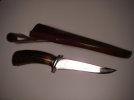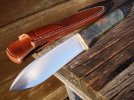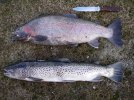I sometimes think maybe we have to have run across and used what we really like certain characteristics of for a while, even if we don't process it as such at the time, and then pick up and use something we really do not like by comparison to get that we really liked what we had.
When Dad and I moved to Florida when I was 9, I had a nice German made hunting knife in carbon steel that I loved and it went everywhere I did. Unfortunately I knew nothing of salt water and the effects it could have on high carbon steel. In a short amount of time the knife ended up getting wet, sheath and all, on a fishing trip and left that way in the boat all week. The blade was in rough shape by the next weekend. Dad took me to the Cutlery Shop at the mall and I picked up a Buck 102 because of the similar pointy trailing tip I was used to and it was a lot like Dad's fillet knives that lived in the boat I also used a lot. So I started collecting Buck knives over the years and a 103 was among them. Later, on a hunting trip in northern Tennessee, I had taken the 103 thinking the skinning knife was the appropriate knife for the trip. Only to learn later that the 102 would have worked just as well for the hunting, and would have worked much better for digging out a locust thorn buried in my calf muscle.
To this day I still own a Buck 102, and i gave that 103 away many years ago. I also still own my old Schrade Golden Spike trailing point hunting knife, several pilot survival knives and a Navy MK-3 MOD-0. But currently only drop points I own other than ones I designed myself are a couple of Fiddlebacks that are very pointy.
I hung out with Ethan while he was developing the Tweener line. I went up and hung out with him a few times that weren't gatherings during that process. When he first did the prototypes he showed me the 16 first and wouldn't let me play with the 17 until I had actually played with the 16 because he knew where my heart would lie. I miss the 17 and hate it was discontinued but such is life. I make clip and swedge a 16 later when i have time

I knew from the discussions during that time he wanted to do a Kephart. Living in the Smokies was probably one of the inspirations for that too. But mostly, and you can see the influence in the 16, he had grown up using a Puma hunting knife just like I had. The difference is he carried the Hunters Pal and a small pointy bladed folder in his youth and did more hunting. I had grown up using a Puma skinner with a trailing point. But then moved to Florida and did a lot more fishing than hunting. I wore shorts all the time and essentially lived in the water. So I seldom carried a folder then and got used to doing everything with a my Buck 102 and then later went to a Buck 117.
When it comes to blade profile preferences it's as much what you get comfortable using in the early years as anything I guess. You can see the Hunter's Pal and Kephart influences in Ethan's BK-11, and I carried one of those for a while because I preferred the secure purchase of the handle over other simple handle designs on the market after so many years of working with my hands coated with blood, oils, and fish slime as a commercial fisherman, and from blood and tallow from hunting. I'm glad he finally got to make his Kephart, and I will buy one just because it's Ethan's dream come true. But I doubt I'll use it as it is n't pointy enough to suit me and i already know that, I'll just save it to remember conversations with him. He knows I like pointy. He has the very first Tibo ever, #R-001, that I gave him in thanks for his friendship, mentoring, and overall good influences in my own life. The world could stand a few more people like Ethan in it.





